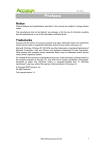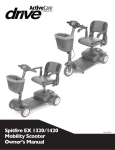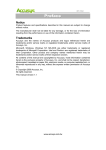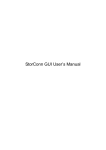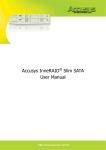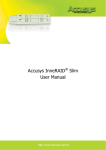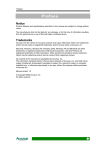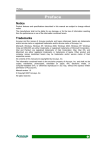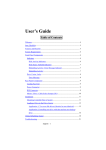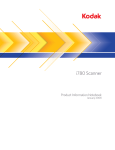Download Accusys ACS-75170 Specifications
Transcript
Preface P Prre effa ac ce e Notice Product features and specifications described in this manual are subject to change without notice. The manufacturer shall not be liable for any damage, or for the loss of information resulting from the performance or use of the information contained herein. Trademarks Accusys and the names of Accusys products and logos referenced herein are either trademarks and/or service marks or registered trademarks and/or service marks of Accusys, Inc. Microsoft, Windows, Windows NT, MS-DOS are either trademarks or registered trademarks of Microsoft Corporation. Intel and Pentium are registered trademarks of Intel Corporation. Other product and company names mentioned herein may be trademarks and/or service marks of their respective owners. All contents of this manual are copyrighted by Accusys, Incite information contained herein is the exclusive property of Accusys, Inc. and shall not be copied, transferred, photocopied, translated on paper, film, electronic media, or computer-readable form, or otherwise reproduced in any way, without the express written permission of Accusys Inc. © Copyright 2008 Accusys, Inc. All rights reserved. This manual version 1.3 1 Accusys 75170 About this manual Intended user This manual is designed and written for users of the ACS-75170 RAID controller. The user should ideally be familiar with RAID planning and data storage operations and have experience in electronic or computer engineering. Organization of the manual This manual consists of the following sections: Chapter 1: Introduction provides details of key features, checklists of package contents and user requirements, and an overview of the RAID box and its features. Chapter 2: Before you begin contains all the information about RAID 1 array and lists important pre-installation notices. Chapter 3: Setting up the controller guides you through process of installing ACS-75170 in a system or externally and explains how to replace drives. Chapter 4: Applications explains how to use the RAID according to different configuration. Appendix A: FAQ helps you deal with encountered problems in the form of Q&A. Appendix B: Glossary defines relevant technical terms used in this manual. Appendix C: Specifications list technical specification of ACS-75170. Appendix D: Regulatory Information provides information of related certification and standards. Appendix E: Contact Us lists contact details of Accusys business units around the world. 2 Preface Using this manual This guide contains all the information you need to set up and start using your RAID controller and to monitor its performance in real time. The setup process will follow these steps: Prepare: Familiarize yourself with the features and capabilities of ACS-75170 (Chapter 1) Information about RAID 1 array (Chapter 2) Install: Attach the necessary cables and either mount the RAID box inside your system or set up the RAID box externally (Chapter 3) Applications: How to use the RAID according to different configuration (Chapter 4) When you have reached this point, your RAID controller will be ready for use. To get the most from your controller, you should also set up the ACSView GUI on your system. With this browser you can monitor the status of your array at any time and from any computer on your LAN. You will find full installation instructions and information on the monitoring capabilities of ACSView in the ACSView (7series GUI) User’s Manual. Ask your vendor for details. 3 Accusys 75170 Guide to Conventions Important information that users should be aware of is indicated with the following icons: This icons indicates the existence of a potential hazard that could result in personal injury, damage to your equipment or loss of data if the safety instruction is not observed. This icon indicates useful tips on getting the most from your RAID controller. Important terms, commands and programs are put in Boldface font. Screen text is given in screen font. 4 Table of Contents T Ta ab blle eo off C Co on ntte en ntts s P R P RE EF FA AC CE E ................................................................................................................. 1 PREFACE NOTICE....................................................................................................................... 1 TRADEMARKS ............................................................................................................ 1 ABOUT THIS MANUAL ................................................................................................. 2 Intended user........................................................................................................ 2 Organization of the manual ................................................................................. 2 USING THIS MANUAL .................................................................................................. 3 GUIDE TO CONVENTIONS ........................................................................................... 4 T A F O T AB BL LE EO O FC C ON NT TE EN NT TS S .................................................................................. 5 TABLE OF CONTENTS CHAPTER 1 .................................................................................................................... 7 IIINTRODUCTION................................................................................................. N NT TR RO OD DU UC CT TIIO ON N 7 OVERVIEW ................................................................................................................. 7 KEY FEATURES ........................................................................................................... 8 Hard drive hot swapping ..................................................................................... 8 Automatic drive rebuilding .................................................................................. 8 MAKING SURE YOU HAVE EVERYTHING ...................................................................... 8 What's in the box.................................................................................................. 8 What else you need............................................................................................... 8 FAMILIARIZING YOURSELF WITH THE CONTROLLER ................................................... 9 Overview .............................................................................................................. 9 Front view ............................................................................................................ 9 Rear view ........................................................................................................... 11 CHAPTER 2 .................................................................................................................. 12 B E O E B EF FO OR RE EY Y OU UB B EG GIIN N .................................................................................... 12 BEFORE YOU BEGIN PRE-INSTALLATION PLANNING ................................................................................. 12 RAID 1 ............................................................................................................... 12 PRE-INSTALLATION NOTICES .................................................................................... 14 CHAPTER 3 .................................................................................................................. 15 S E P H O S ET TT TIIN NG GU U PT T HE EC C ON NT TR RO OL LL LE ER R SETTING UP THE CONTROLLER....................................................... 15 INSTALLATION FLOWCHART ..................................................................................... 15 MOUNTING RAID BOX ............................................................................................. 16 5 Accusys 75170 Mounting RAID box in system ........................................................................... 16 LOADING DRIVES IN THE RAID BOX......................................................................... 17 Fixed connector drive carrier ............................................................................ 17 REMOVING / REPLACING A DRIVE ............................................................................. 19 Swapping drives ................................................................................................. 19 What if a disk fails?............................................................................................ 19 Removing a drive from a fixed connector drive carrier..................................... 19 FIRMWARE UPDATING STEPS.............................................................................. 20 CHAPTER 4 .................................................................................................................. 22 A P A PP PL LIIC CA AT TIIO ON N APPLICATION.................................................................................................... 22 Application 1: Two new disk drives (identical or non-identical) ....................... 22 Application 2: Installing one drive with data and one new drive ...................... 22 APPENDIX A ................................................................................................................ 23 F A F AQ Q ............................................................................................................................. 23 FAQ APPENDIX B ................................................................................................................ 24 G L G LO OS SS SA AR RY Y ........................................................................................................... 24 GLOSSARY APPENDIX C ................................................................................................................ 26 S P S PE EC CIIF FIIC CA AT TIIO ON NS S ............................................................................................ 26 SPECIFICATIONS APPENDIX D................................................................................................................ 27 R E N R EG GU UL LA AT TO OR RY Y IIINFORMATION NF FO OR RM MA AT TIIO ON N ........................................................... 27 REGULATORY APPENDIX E ................................................................................................................ 28 C O S C ON NT TA AC CT TU U S ...................................................................................................... 28 CONTACT US ACCUSYS, INC. ......................................................................................................... 28 ACCUSYS U.S.A., INC. ............................................................................................. 28 ACCUSYS KOREA, INC.............................................................................................. 28 ACCUSYS CHINA, INC............................................................................................... 28 ACCUSYS EU, BV. ................................................................................................... 29 6 Chapter 1 – Introduction Chapter 1 IIn nttrro od du uc cttiio on n This chapter introduces the features and capabilities of ACS-75170. You will find: A full introduction to your ACS-75170 controller Details of key features A checklist of package contents A checklist of what else you need to start installation An overview of the RAID box and its features, including connectors, LEDs and jumpers Overview Congratulations on your selection of the Accusys 75170 (ACS-75170). The ACS-75170 is a high-performance and extremely flexible solution for RAID 1 disk mirroring. With a cost effective SATA approach, the ACS-75170 mirrors data to the other disk drive simultaneously, and delivers optimized performance. If one drive fails, data is secured by the other drive and alarm sounds to alert you. Featuring intelligent online recovery, ACS-75170 let you hot swap a failed drive and it automatically rebuilds the data to the new drive without any system down time. The 75170 RAID box features a user-friendly rack design that lets you easily install a backup drive, or replace a drive that fails. Each hard drive carrier supports a one-inch high 3.5 inch for factor disk drive. Additional data security is provided by a key-locking system, that prevents unauthorized access to each disk drive. 7 Accusys 75170 Key features The ACS-75170 supports the following features: Support 2 SATA-I disk channels Support one SATA-I host channel Support RAID level 1 OS independent (No driver needed) 2MByte memory buffer Support front panel disk operation LED indicator Disk hot swapping supported Automatic drive failure detection Automatic on-line drive re-build Audible alarm on drive failure Battery backup for disk rebuild status Support ATA-6 big drive function Support GUI 7 series spec. (Rev. 1.01 or above) Hard drive hot swapping Hot Swapping allows for the removal and installation of disk drives without the need to power down the system while ACS-75170 is configured as a RAID 1 array. Automatic drive rebuilding If a member drive in a RAID 1 array is replaced on-line, the controller will automatically start to rebuild data to the new drive. Making sure you have everything What's in the box Some vendors may ship certain components as standard, while other vendors treat the same component as optional. In its most basic configuration, your package should include the following: ACS-75170 RAID Box ACS-75170 Controller User’s Manual and GUI management software Two disk drive carriers with key locks Disk drive mounting screws Two keys for drive carriers (identical) What else you need In order to setup a working system the following user-supplied items are required: System with SATA Interface Case with two half-height 5 ¼” drive bays with front bezel access One SATA channel cable connector One free power supply connector at least One 3-pin RS232 cable connector (data connection for GUI interface, if required) 8 Chapter 1 – Introduction Familiarizing yourself with the controller Overview The RAID box has two drive carriers, accessed from the front. The sides of the box each feature a guide rail channel and mounting screw holes to enable the box to be secured inside a computer case. The connectors and jumpers are located on the rear panel. Top /Down Drive carrier Rebuilding activity/Error message indicator Disk status/ Rebuild indicators Guide rail channel Holes for mounting screws Rear / Connectors & jumpers Front view Two Drive Carriers Disk Activity Indicators Drive Carrier Lock Each drive carrier can hold a one-inch high 3.5-inch form factor hard disk drive. This makes it easy to hot swap a drive in the event of a failure, without affecting the status of the remaining drives. Drive Carrier Lock – Unlocked orientation Drive Carrier Lock – Locked orientation Green Disk Activity Indicator Amber Disk Activity Indicator Red Disk Activity Indicator 9 Accusys 75170 Disk Activity Indicators These indicators show the status of each individual disk drive. Indicator Green Amber Red Red Flashing Disk Activity Disk drive is properly installed and locked Disk drive is being accessed Disk drive is not present, is not properly installed, is unlocked, or disk has failed Disk drive is rebuilding data. In the event that a drive fails, the Red indicator turns on and an alarm sounds. You can turn off the alarm by unlocking the drive carrier. The drive carrier lock acts as an On/Off switch for the drives and provides security by preventing non-key holders from accessing the drives. To lock each carrier, insert the key and turn it in a clockwise direction. To unlock a carrier, turn the key in a counterclockwise direction. Disk Status/ Rebuild Indicators The upper indicator represents the top drive carrier, the lower indicator represents the bottom drive carrier. If a drive fails, the appropriate indicator turns on and an audible alarm sounds. You can turn off the audible alarm by unlocking the drive carrier. The red indicator of the target disk will light up and blink while rebuilding. Rebuilding Activity/ Error Message Indicator Rebuilding Activity: This row of eight indicators shows disks rebuilding activity. In normal operation, a green light scans across the bank of indicators. If you are using the online recovery feature to rebuild a drive, all the indicators will turn on at the same time. The left-side indicator blinks and then turns off when 12.5% of the data has been mirrored. Then the next indicator blinks and turns off when 25% of the data has been mirrored, and so on. Error Message The chart offers the all-possible error messages, and can help you to identify certain problems. ★ Drive carriers LED Error Status Display ☆ Disk Fail (Replace the failed disk with another disk) ☆ Target Disk Size small than Source Disk (Replace the failed target disk with a disk that its size is greater or equal to the source disk.) 10 Chapter 1 – Introduction ☆ Disk has bad sector (replace the failed disk with another disk) ☆ Fan Fail (Contact with Accusys product support center) ☆ No battery (Contact with Accusys product support center) ☆ Power ON Channel 1 Fail (Call or email Accusys product support center) ☆ Power ON Channel 2 Fail (Call or email Accusys product support center) Rear view Connector for SATA interface cable RAID level configuration jumper pins Power connector 3-pin RS232 connector (Terminal port) Cooling fan vent The SATA cable is the route used for reading and writing to the array. The power connector supplies power to the controller box. In order to provide stable power, we recommend to connect both power connectors on the RAID box. The 3-pin RS-232 cable is used for remote monitoring of ACS-75170. The RS-232 port is configured with DTE and PC compatible pin assignments. There is a triangular symbol “▲” on both PCB connector and RS-232 cable connector, please make sure you connect in the right direction (both triangle symbols match each other). Connecting in wrong direction will not damage RAID controller, however the terminal or GUI will not work. The cooling fan inside the RAID box provides air circulation for the disk drives. DO NOT change the RAID level configuration jumpers. They have been set and ready for use when the controller is delivered. 11 Accusys 75170 Chapter 2 B Be effo orre ey yo ou ub be eg giin n This chapter contains includes all the information about RAID level and preparing for installation. You will find: A full introduction to and comparison of RAID level 1 Important notices on the safe operation and installation of ACS-75170 Pre-installation planning RAID 1 The ACS-75170 can support the following RAID level 1. RAID 1 is commonly referred to as Disk Mirroring, Disk Shadowing or Disk Duplexing as all data is duplicated across both disks. RAID 1 can only be performed with two hard drives (with four drives, RAID 0+1 is configured automatically). As data is identical on both disks, storage capacity is that of the smaller disk. RAID 1 has poor performance for write operations but very high performance for read intensive operations. Further information on RAID concepts can be found in Appendix B, Glossary. RAID 1: Mirroring Characteristics: Better Read transaction rate then single disks, same Write transaction rate as single disks. 100% redundancy of data means no rebuild of data is necessary in case of disk failure, just a copy to the replacement disk. All the disks have the same data. Raid level 1 requires two drives. Storage capacity = Capacity of smaller disk 12 Recommended use: Accounting Payroll Financial Any application requiring high availability Chapter 2 – Before you begin Arrangement of data blocks saved on a Level 1 array 13 Accusys 75170 Pre-installation notices Before starting any kind of hardware installation, please ensure that all power switches have been turned off and all power cords disconnected to prevent personal injury and damage to the hardware. To avoid overheating, ACS-75170 should be installed in a well-ventilated area and in such a way that sufficient airflow is maintained across the controller chips. Static electricity can damage electronic components. To guard against such damage: Work in a static-free environment Wear a grounded anti-static wrist strap Store uninstalled components in anti-static bags Handle PCBs by their edges and avoid touching chips and connectors. Environmental requirements: Temperature: 0-50℃ Operating Humidity: 5-95%, non-condensing Storage Humidty: 5-75% 14 Chapter 3 –Setting up the controller Chapter 3 S Se ettttiin ng gu up p tth he ec co on nttrro olllle err This chapter explains how to: Check RAID level on RAID box Install the RAID controller in a system or externally Load hard drives into ACS-75170 Swap drives Installation flowchart Installation of ACS-75170 is simple. This chapter will lead you though the following steps: Install controller Load hard When the controller is fully configured, connect a power and SATA cable and install it either in a system or externally. When the controller is installed, load a hard drive into each of the drive carriers drives 15 Accusys 75170 Mounting RAID box The ACS-75170 RAID box can be installed inside a computer case or set up externally. This section describes both procedures. Turn off and disconnect all electrical power from the system before beginning installation. Mounting RAID box in system The ACS-75170 RAID box fits into the space of the half-height 5¼-inch drive bay. 1. Remove the cover and front bezel from the system case. 2. Feed a power cable opening. through the 3. Feed an SATA cable opening. through the 4. Connect the two cables to the connectors on the rear of the RAID box. 5. If planning to use the ACSView GUI to monitor the status of your RAID, you should also connect a 3-pin RS-232 cable to the terminal on the RAID box. 6. Insert the RAID box into the bay, and secure it in place with the screws provided. (If your case uses guide rails to install 5¼-inch devices, you can use them on the RAID box.) In order to provide stable power, we recommend to connect both power connectors on the RAID box. 16 Chapter 3 –Setting up the controller Loading drives in the R RA AIID D bbooxx There one type of drive carrier available for ACS-75170 controller: 1. Fixed SATA connector Drive Carrier Fixed SATA Connector Fixed connector drive carrier The ACS-75170 should be fitted with two hard disk drives. Load each drive into a drive carrier as follows: Unlock the drive carrier and slide it out of the controller box. 2. Place the disk drive in the drive carrier, so that the SATA connector is lined up with the connector inside the carrier. 3. Carefully push the disk drive so that the drive’s SATA connector is seated securely into the SATA connector in the disk carrier. 4. Secure the disk drive by screwing it to the drive carrier case. 5. Slide the loaded disk drive carrier into the ACS-75170 RAID Box and lock it. 17 Accusys 75170 The disk carrier connector at the back of each RAID box disk carrier slot can be damaged if the disk carrier is not properly aligned when inserted. Insert the disk carrier gently to avoid damage. 18 Chapter 3 –Setting up the controller Removing / replacing a drive Swapping drives The hot swap function is available on the RAID 1 array and can be operated during run time. RAID rebuilding will be processed automatically in the background and the ACS-75170 RAID subsystem will record its progress. If the host system is shut down or powered off abnormally, the ACS-75170 RAID subsystem will continue the disk rebuilding process after power is turned on again. A hard disk should not be replaced when the system is turned off. Doing so may leads to loss of data. What if a disk fails? If a disk drive fails, or a key switch is turned off, the red disk activity indicator of its disk carrier will light and the alarm will sound (sound when only disk fails). When this happens, you can replace the failed disk with a new one, then turn the key switch on. Removing a drive from a fixed connector drive carrier 1. Unlock the appropriate disk carrier. The red disk activity indicator will light. 2. Slide the drive carrier out of its slot. 3. Slide the disk drive to the front of the carrier so that the SATA connector is freed from the drive carrier. 4. Lift out the disk drive. 19 Accusys 75170 Firmware updating steps 1. Ensure the ACS-75170 is turned off. 2. Connect the RS-232 cable to the RS-232 3pin port (Please refer the page 11 “Rear View”), and connect the other end to one of the host computer’s COM port. 3. Launch HyperTerminal from the host computer: Start > Programs > Accessories > Communications > HyperTerminal. 4. Select COM1 or COM2 from the Connect using: dropdown menu, depending on which port is connecter to ACS-75170. 5. The COM properties dialog box will appear. Set the following values: Bit per second: 19200 Data bits: 8 Parity: None Stop bits: 1 Flow Control: Xon/Xoff 20 Chapter 3 –Setting up the controller 6. Turn on the ACS-75170 and press the ESC button on the host computer keyboard. The “>>>” prompt will appear. 7. Type in the command “download” to go to the firmware download mode, then type “1” to download code (Firmware or Bootcode). >>> download restart … 01 GPIO 01 AAA 01 01 ========= 76 Download Mode ========= Enter ‘1’ to Download Code (Firmware, Bootcode) ‘ESC’ exit 8. Locate the updates firmware file to send. For HyperTerminal, go to the Transfer menu and select Send Text File. 9. Send the firmware file as a text file. The file will start to download. Caution Do not turn off the system or interrupt program during firmware-updating procedure. 10. When the file has been downloaded, after ACS-75170 restarted, the firmware-updating procedure is finished. 21 Accusys 75170 Chapter 4 A Ap pp plliic ca attiio on n This chapter explains how to start using the RAID according to different configuration. If you have installed two new disk drives go to Application 1. If you have installed one drive with data and one new disk drive go to Application 2. Application 1: Two new disk drives (identical or non-identical) 1. Lock both drive carriers and it is ready for use. Application 2: Installing one drive with data and one new drive 1. The new drive must have the same capacity or a larger capacity than the drive with data. 2. Lock the drive with data and leave the new drive unlocked. This identifies the drive with data as the source drive. When you lock the drives, the first drive to get locked is designated as the source drive and the other drive becomes the backup drive. 3. Turn on the computer system. . 4. After the boot process is complete, lock the new drive. This identifies the new drive as the target drive. 5. The system will immediately begin mirroring the data from the source drive to the target drive. Any old data on the target drive will be lost, and is overwritten with the mirror image of the source drive. Risk of Explosion if Battery is replaced by an Incorrect Type. Dispose of Used Batteries According to the Instructions 22 Appendix A –FAQ Appendix A F FA AQ Q If you encounter a problem while using the ACS-75170, check this section for help. 1. When I lock a drive carrier with a disk drive in place, the red disk activity indicator turns on and an alarm beep sounds. Why? (a) Make sure you firmly connect the SATA connector of the HDD to their counterparts inside the drive carrier and try again. If this does not solve the situation, go to (b). (b) Change the disk drive with a new one and try again. (c) Exchange the top and bottom drive carriers and try again to determine if the carrier itself is faulty. (d) If all of the above steps fail, contact your vendor. 2. How can I turn off the alarm beep sound when there is a hard disk failure? Unlock the drive carrier of the failed disk. This will turn off the alarm beep sound. 23 Accusys 75170 Appendix B G Gllo os ss sa arry y Array See Disk Array. Array Management Software The body of software that provides common control and management for a disk array. Array Management Software most often executes in a disk controller or intelligent host bus adapter, but may also execute in a host computer. When it executes in a disk controller or adapter, Array Management Software is often referred to as Firmware. Cache Controller memory used to speed up data transfer to and from a disk. Disk Array A collection of disks from one or more commonly accessible disk controllers, combined with a body of Array Management Software. Array Management Software controls the disks and presents them to the array operating environment as one or more virtual disks. Disk Striping The practice of dividing data into blocks and writing the blocks across several drives for increased performance. Disk Mirroring The practice of duplicating data on different sets of disks in an array. Firmware See Array Management Software. Host Computer Any computer system to which disks are directly attached and accessible for I/O. Mainframes, and servers, as well as workstations and personal computers, can all be considered host computers in the context of this manual, as long as they have disks attached to them. Hot Spare A physical drive, not part of an array, on which the controller can rebuild data if an array drive malfunctions. 24 Appendix B – Glossary Hot Swap The substitution of a (usually defective) unit by a replacement that takes place while the system is online. Logical Unit Disk storage space on one or more physical drives that appears to the host computer as a single drive. LUN (Logical unit number) The number assigned to a logical unit. Slices of a RAID are assigned (mapped to) LUNs by which they appear to the host computer. Mirroring See Disk Mirroring. Parity Parity information is redundancy information calculated from actual data values. If any single piece of data is lost, the data remaining and the parity information can be used together to compute the lost data. Parity information can either be stored on a separate, dedicated drive, or be mixed with the data across all the drives in the array. RAID (Redundant Array of Independent / Inexpensive Disks) A disk array in which part of the storage capacity is used to store redundant information about user data stored on the remainder of the storage capacity. The redundant information enables regeneration of user data in the event that one of the array member disks or the access path to it fails. See Parity. Different RAID levels offer different data throughput speeds and fault tolerance (data redundancy). RAID 0 does not feature redundant information but is nonetheless considered a special type of RAID. SCSI Small Computer System Interface. Slice A partition of an array. See LUN. Striping See Disk Striping. 25 Accusys 75170 Appendix C S Sp pe ec ciiffiic ca attiio on ns s Host interface Disk interface RAID levels supported Form factor Dimensions Weight Hot swap Event alarm FAN 1 x SATA-I SATA-I (support SATA-II disk but run in SATA-I mode) 1 Full height/ Two 5.25 inch half height W5.75×D8.84×H3.35 (inch) <= 2KG W/O Disk Yes (Rebuilding is transparent & automatic) Yes, built-in buzzer on board Rated Speed: 4700RPM+/- 400RPM Noise Level: 35dB(A) Specifications are subject to change without notice. 26 Appendix D – Regulatory information Appendix D R Re eg gu ulla atto orry y iin nffo orrm ma attiio on n FCC Statement This equipment has been tested and found to comply with the limits for a Class B digital device, pursuant to Part 15 of FCC Rules. These limits are designed to provide reasonable protection against harmful interference in a residential installation. This equipment generates, uses, and can radiate radio frequency energy and, if not installed and used in accordance with the instructions, may cause harmful interference to radio communications. However, there is no guarantee that interference will not occur in particular installation. If this equipment does cause harmful interference to radio or television reception, which can be determined by turning the equipment off and on, the user is encouraged to try to correct the interference by one or more of the following measures: 1. Reorient or relocate the receiving antenna. 2. Increase the separation between the equipment and receiver. 3. Connect the equipment into an outlet on a circuit different from that to which the receiver is connected. 4. Consult the dealer or an experienced radio/television technician for help. The changes or modifications not expressly approved by the party responsible for compliance could void the user’s authority to operate the equipment. Shielded interface cables, if any, must be used in order to comply with the emission limits. CE Mark This equipment is in conformity with the EMC directive. UL Listed This equipment meets UL's safety requirements. 27 Accusys 75170 Appendix E C Co on ntta ac ctt U Us s A sys, IInc. nc. Accccuusys, • 5F, No. 38, Taiyuan St., Jhubei City, Hsinchu County 30265, Taiwan (R.O.C.) • Tel : +886-3-560-0288 • Fax : +886-3-560-0299 • http://www.accusys.com.tw/ • e-mail : [email protected] A sys U .S.A., IInc. nc. Accccuusys U.S.A., • 46710 Fremont Blvd. Fremont, CA 94538, U.S.A. • Tel:+1-510-661-0800 • Fax:+1-510-661-9800 • Toll-free number:+1-866-277-5888 • http://www.accusysusa.com/ • e-mail : [email protected], [email protected] orea, IInc. nc. A sys K Accccuusys Korea, • Baegang B/D 5F Shinsa-Dong 666-14 Kanggnam-Gu, Seoul, Korea • Tel : (02)6245-9050 • Fax : (02)3443-9050 • http://www.accusys.co.kr/ • e-mail : [email protected] A sys C hina, IInc. nc. Accccuusys China, • #1701, Blk B, Horizon International Tower, No. 6 Zhichun Street, Haidian District, Beijing, China 28 • China Postal Code:100088 • Tel: +86-10-82800080 /81 /82/ 83 • Fax: +86-10-82800784 • Web: www.accusys.com.cn • Sales: [email protected] • Support: [email protected] Appendix E – Contact Us 世 科技北京代表处 世仰 仰科技北京代表处 • 地址 : 北京市海淀区知春路 6 号 锦秋国际大厦 B 座 1701 • 邮编 : 100088 • 电话 : +86-10-82800080 /81 /82 /83 • 传真 : +86-10-82800784 • 网址 : www.accusys.com.cn • Mail : [email protected] • Support : [email protected] A sys E U, B V. Accccuusys EU, BV. • Columbusstraat 22-26, Distripark Eemhaven, 3165 AD Rotterdam, Netherlands • Tel : +31-10-2995761 • Fax : +31-10-4292194 • Http://www.accusyseu.com • e-mail : [email protected] 29





























